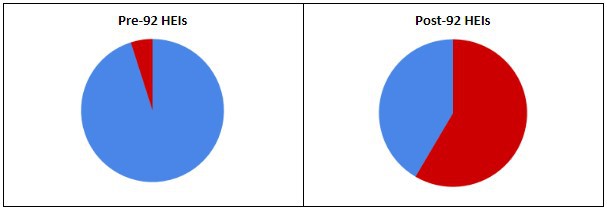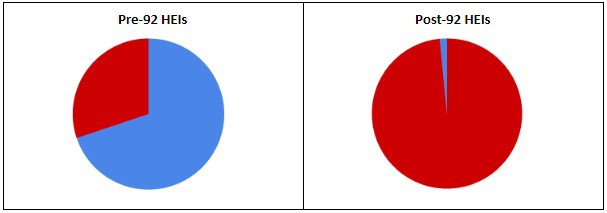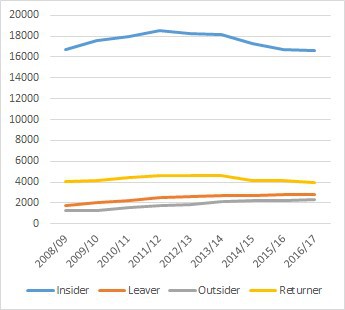In 2009, the Economic and Social Research Council announced a significant change in the way that it supported doctoral training in the UK.
Rather than awarding recognised status and a set number of funded doctorates to individual university departments, it called for the establishment of doctoral training centres (DTCs) and doctoral training units (DTUs).
It received fifty-seven applications involving 98 institutions, but a Government Spending Review in 2010 cut the ESRC’s funding, and subsequently only twenty-one DTCs (and no DTUs) were awarded. These admitted their first cohort of students in 2011, and their last one in 2016; they have since been replaced by larger doctoral training partnerships (DTPs) as of 2017.
So far, most research on these centres has come from academics who were a part of them. They identified difficulties in setting up and running what are essentially new organisational entities that span departmental, and often university, lines.
We were interested in the potential impact of this policy outside the ESRC circle – as well as how it was experienced by those within it. Starting in the summer of 2016 we interviewed 60 senior academics, research managers, and doctoral students and analysed HESA data on doctoral numbers. We published our report earlier this week.
DTCs in the sector
Of around 120 HEIs with postgraduate research degree awarding powers (RDAP) eighty-three were eligible for ESRC funding in 2010, the year before DTCs were launched. This number was effectively halved under the DTC policy. The ESRC’s own review of DTCs – which resulted in the 2015 Bartholomew Report – highlighted that this exclusion of some universities from ESRC funding was a concern. These included “pockets of excellence” – universities with strong research in certain areas, rather than across the university – as well as post-92 universities in general. Our analysis captured the extent of post-92 institutions’ exclusion: twenty-eight had access to ESRC doctoral funding in 2010, while only one did in 2011. Given that these universities recruit many of their students from less affluent social groups, the DTC policy may have enhanced a degree of social exclusion in access to doctorates.
Table 1: Pre/Post-92 – with RDAP – ESRC Doctoral Eligibility (in blue) in 2010

Table 2: Pre/Post-92 ESRC – with RDAP – Doctoral Eligibility (in blue) 2011-16

In relation to ESRC doctoral funding, we can characterise institutions as being divided into four main groups:
- Insiders: with ESRC funding in 2010, 2011-16, and 2017 onwards (44:0, pre-/post-92)
- Returners: with ESRC funding in 2010 and 2017 onwards DTCs (14:12)
- Leavers: with ESRC funding in 2010 but not regaining it since (2:15)
- Outsiders: without ESRC funding over this period (3:32)
The fact that many have returned to funding highlights that research-intensive/teaching-intensive pre-92/post-92 divide is not as clear cut as often collected.
We were also interested to see if there were any effects on doctoral numbers across the sector. We might expect, for example, that insiders – of high status, with the added attraction of ESRC-accreditation and scholarships – would steal a march on their competitors. What we saw, though, was that the insiders are actually losing ground to the other groups. Connecting this to DTCs is difficult, particularly as ESRC doctorates only make up about 20% of the insiders’ social science doctoral numbers, but it is curious that the decline starts in 2011, which is when the DTCs became operational.
There is also a small downturn in returners numbers, but they and the other groups appear to have weathered the loss/absence of ESRC funding relatively well by drawing on other doctoral funding sources.
Table 3: Social Science Doctoral Numbers 2009-2017

Organisational Impact
Across our sample the collaborative, interdisciplinary doctoral training model was viewed in positive terms, at least in principle. However, in terms of the DTC policy’s implementation – from the perspective of those with one, and those without – there was evidence of significant problems.
For staff working in DTCs, two major issues featured across the staff accounts. The first was that the establishment and ongoing management of a DTC was uniformly described as enormously resource-intensive. This was partly due to a heavy burden of reporting and other administrative structures imposed by the ESRC.
Secondly, DTCs were expected to sit across departmental, disciplinary – and in many cases, university – boundaries, and this created a number of ongoing internal political tensions, not least at the point where scholarships were divided up between partners every year.
For those outside the DTCs, the loss or absence of funding – and status – was felt keenly. HEIs with significant and well-developed doctoral provision and a history of receiving ESRC studentships struggled to retain some of their research training. They were also forced to draw heavily on internal funding and international students to maintain and develop their PGR communities. For others, where they had ambitions to develop their doctoral cultures, they continued to feel hamstrung by the lack of external support to do so.
Doctoral students in insider universities, even those who were part of a DTC, reported feeling little awareness, presence, or benefit of a DTC. They, and some of the returner university students, did seem to have access to more research training, but this was not always seen as very good. What was common for almost all of the students, though, was that they did not feel particularly valued by their institutions or welcomed within their university’s research communities.
Did DTCs do any good?
It seems that DTCs as a policy solution did not really work – at least according to our study. In addition to even further dividing the sector into haves and have-nots, there are potentially serious social justice implications with respect to access to doctorates. Organisationally, it is perhaps the case that, as a new policy, expectations were too high. At the same time, though, aspects of its implementation did hamper its chances of success.
In terms of the wider sector, there are two key questions which need to be addressed. The first is the relationship between other policies – in particular the REF – and DTCs, not least in the sense that eligibility for the ESRC DTPs, which replaced DTCs, is dependent on 3* REF returns across the board.
Given that having (or not having) a DTC may affect the environment metric, it could be that outsiders will never be able to access ESRC doctoral support. Secondly, the ESRC was to some extent copying the EPSRC’s CDT model (which is currently receiving attention in the press), and these forms of doctoral training centre/partnership are widespread – there are now over 200 across UK HE. There is, though, very little research on them, and we therefore know little about how – and whether – they are working.
Catherine O’Connell, Tingting Yuan and Olga Ververi also contributed to this article.














I would be nice to mix more qualitative/human interest data in with the helicopter view stuff, otherwise this can get a little dry and you come away not really sure why you read it. As someone who has helped edit PhDs for struggling candidates but does not hold one myself I am very interested in seeing more about the nitty-gitty of the field, particularly the complex politics surrounding assessment criteria. I’m not seeing enough engagement with the more ‘dangerous’ material at the moment.
Also, I don’t seem to be seeing any way of editing the typo in my above post. Perhaps something you could think about adding?
There was scant space in the report – and therefore in this blog – for qualitative quotes, but point taken. We also weren’t looking at the PhD itself, rather the ways in which state funding was channelled. There is, though, a pretty considerable pedagogical literature on PhDs.